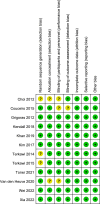Perioperative intravenous lidocaine for postoperative pain in patients undergoing breast surgery: a meta-analysis with trial sequential analysis of randomized controlled trials
- PMID: 37427130
- PMCID: PMC10327428
- DOI: 10.3389/fonc.2023.1101582
Perioperative intravenous lidocaine for postoperative pain in patients undergoing breast surgery: a meta-analysis with trial sequential analysis of randomized controlled trials
Abstract
Background: The effectiveness of intravenous lidocaine infusion in managing acute and chronic pain following breast surgery has been a topic of debate. This meta-analysis aims to assess the impact of perioperative intravenous lidocaine on the relief of postoperative pain among patients undergoing breast surgery.
Methods: A systematic search of databases was conducted to identify randomized controlled trials (RCTs) that compared the effects of intravenous lidocaine infusion with placebo or routine care in patients undergoing breast surgery. The primary outcome of interest was the occurrence of chronic post-surgical pain (CPSP) at the longest follow-up. Meta-analyses, incorporating trial sequential analysis, were performed using a random-effects model to assess the overall effect.
Results: A total of twelve trials, involving 879 patients, were included in the analysis. Perioperative intravenous lidocaine demonstrated a significant reduction in the incidence of CPSP at the longest follow-up (risk ratio [RR] 0.62, 95% confidence interval [CI] 0.48-0.81; P = 0.0005; I2 = 6%). Trial sequential analysis (TSA) indicated that the cumulative z curve crossed the trial sequential monitoring boundary for benefit, providing sufficient and conclusive evidence. Furthermore, intravenous lidocaine was associated with decreased opioid consumption and a shorter length of hospital stay.
Conclusion: Perioperative intravenous lidocaine is effective in relieving acute and CPSP in patients undergoing breast surgery.
Systematic review registration: https://inplasy.com/, identifier INPLASY2022100033.
Keywords: breast surgery; chronic post-surgical pain; lidocaine; meta-analysis; opioid.
Copyright © 2023 Li, Huang, Yang and Liu.
Conflict of interest statement
The authors declare that the research was conducted in the absence of any commercial or financial relationships that could be construed as a potential conflict of interest.
Figures






Similar articles
-
Association between perioperative intravenous lidocaine and subjective quality of recovery: A meta-analysis of randomized controlled trials.J Clin Anesth. 2021 Dec;75:110521. doi: 10.1016/j.jclinane.2021.110521. Epub 2021 Sep 20. J Clin Anesth. 2021. PMID: 34547603 Review.
-
Effect of Perioperative Intravenous Lidocaine Infusion on Acute and Chronic Pain after Breast Surgery: A Meta-Analysis of Randomized Controlled Trials.Pain Pract. 2017 Mar;17(3):336-343. doi: 10.1111/papr.12442. Epub 2016 Feb 23. Pain Pract. 2017. PMID: 26913591
-
Effect of intravenous lidocaine on chronic postoperative pain in patients undergoing breast cancer surgery: a prospective, double-blind, randomized, placebo-controlled clinical trial.Ann Transl Med. 2022 Jul;10(14):803. doi: 10.21037/atm-22-3522. Ann Transl Med. 2022. PMID: 35965825 Free PMC article.
-
Perioperative Intravenous Lidocaine Infusion for Postoperative Analgesia in Patients Undergoing Surgery of the Spine: Systematic Review and Meta-Analysis.Pain Med. 2022 Jan 3;23(1):45-56. doi: 10.1093/pm/pnab210. Pain Med. 2022. PMID: 34196720
-
Effects of Ketamine on Chronic Postsurgical Pain in Patients Undergoing Surgery: A Systematic Review and Meta-analysis.Pain Physician. 2023 May;26(3):E111-E122. Pain Physician. 2023. PMID: 37192226
Cited by
-
Perioperative intravenous lidocaine infusion improves postoperative analgesia after hysterectomy: a systematic review and meta-analysis of randomized controlled trials.Int J Surg. 2025 Jan 1;111(1):1265-1274. doi: 10.1097/JS9.0000000000001942. Int J Surg. 2025. PMID: 38976912 Free PMC article.
-
Effect of perioperative lidocaine infusion on the subjective quality of recovery after surgery: Protocol for an updated systematic review and meta-analysis.PLoS One. 2025 May 13;20(5):e0323342. doi: 10.1371/journal.pone.0323342. eCollection 2025. PLoS One. 2025. PMID: 40359208 Free PMC article.
References
Publication types
LinkOut - more resources
Full Text Sources
Research Materials

